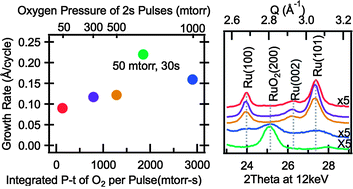The low temperature atomic layer deposition of ruthenium and the effect of oxygen exposure†
Abstract
We have studied the atomic layer deposition (

* Corresponding authors
a
Department of Chemical Engineering, Stanford University, 381 North-South Mall, Stanford, CA 94305, USA
E-mail:
bent@stanford.edu
Fax: +1 650 723 9780
Tel: +1 650 723 0385
We have studied the atomic layer deposition (

 Please wait while we load your content...
Something went wrong. Try again?
Please wait while we load your content...
Something went wrong. Try again?
R. Methaapanon, S. M. Geyer, H. Lee and S. F. Bent, J. Mater. Chem., 2012, 22, 25154 DOI: 10.1039/C2JM35332F
To request permission to reproduce material from this article, please go to the Copyright Clearance Center request page.
If you are an author contributing to an RSC publication, you do not need to request permission provided correct acknowledgement is given.
If you are the author of this article, you do not need to request permission to reproduce figures and diagrams provided correct acknowledgement is given. If you want to reproduce the whole article in a third-party publication (excluding your thesis/dissertation for which permission is not required) please go to the Copyright Clearance Center request page.
Read more about how to correctly acknowledge RSC content.
 Fetching data from CrossRef.
Fetching data from CrossRef.
This may take some time to load.
Loading related content
